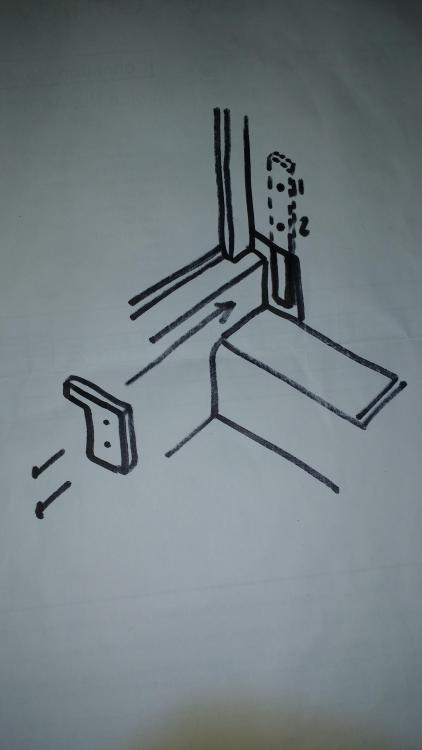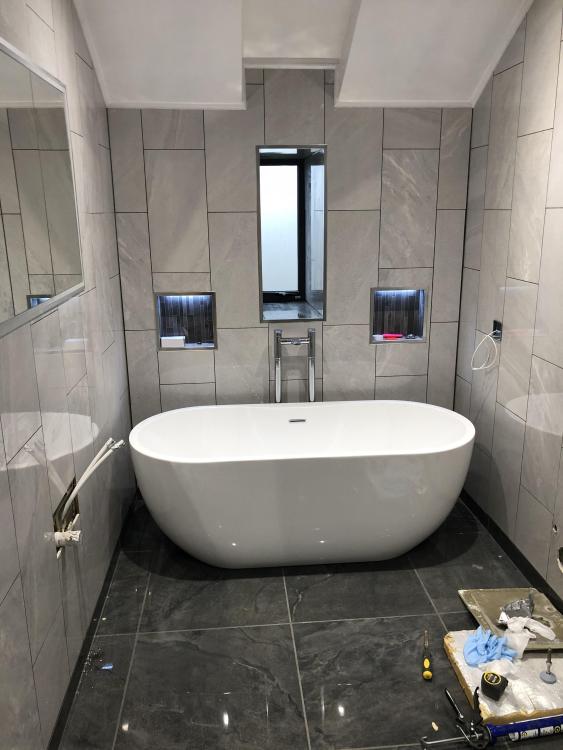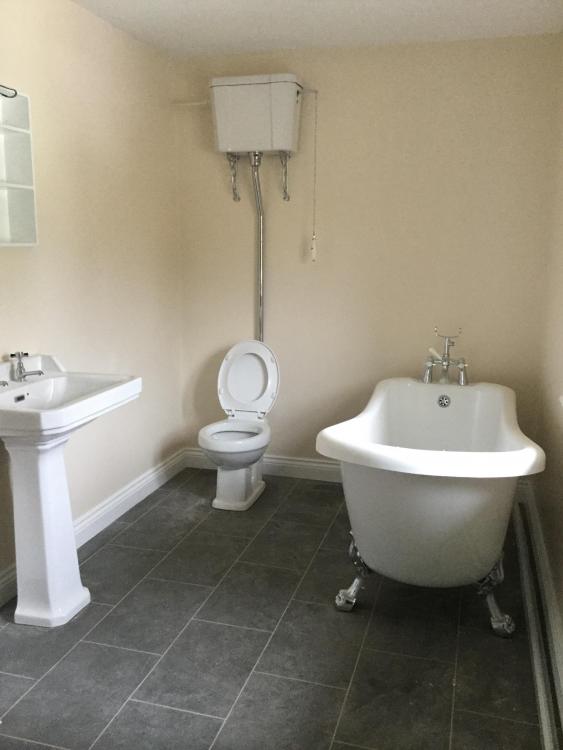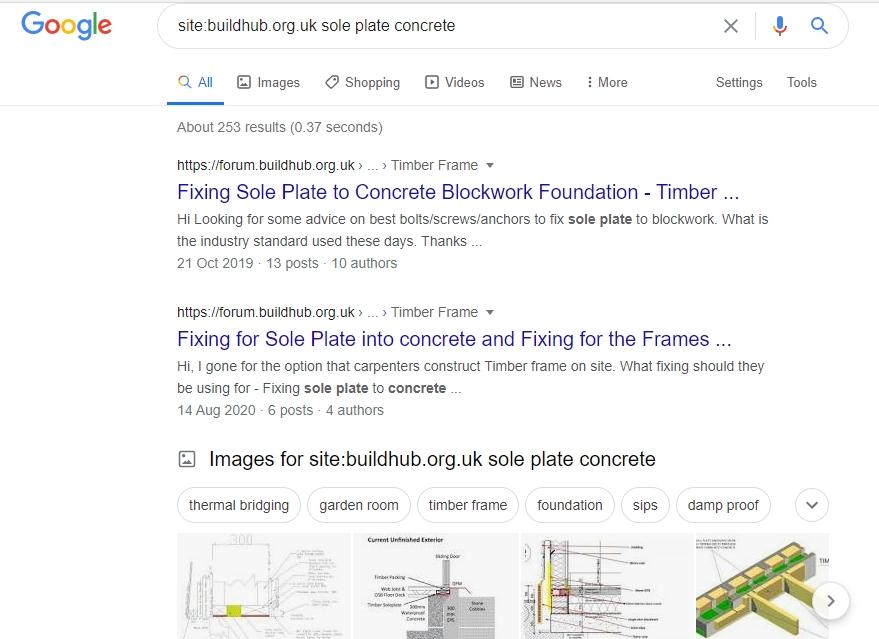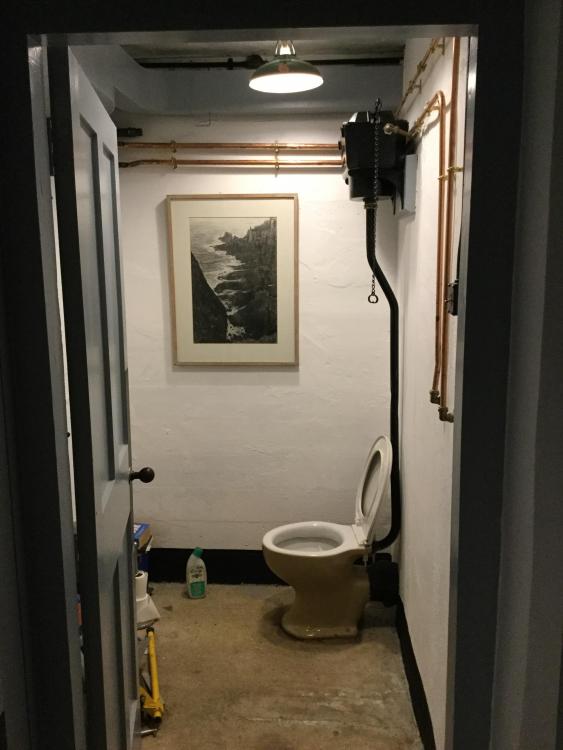Leaderboard
Popular Content
Showing content with the highest reputation on 01/27/21 in all areas
-
5 points
-
What they said! A strip of softwood say 1" x 1/2" or similar. Stick it up inside the cavity, vertically or horizontally, it doesn't matter. You might want to drill through the plasterboard and into the strip first to pilot it and stop it splitting when you put the screws in. Two plasterboard screws at 1&2 to hold it. Then cut a piece of pb to fill the gap. You can either screw or stick that to the wood. Leave a nominal gap around the infill piece. I usually fill the gap with something like No Nails, Sticks Like Sh!t etc. Then fill over the top and sand/paint. Why is that bit missing, the shower isn't leaking there is it?3 points
-
They usually sit an an angle to maximise light spread and reduce the "tunnel" effect up to the window.3 points
-
3 points
-
Now done all 11 (3 had remote sensors so not affected), recalibrated them and I now have much more stable temperature control, so very pleased with the result. As previously said, I measured the temperate of the top slot probing into the back. 29 degrees! Have sent a new design to Heatmiser. Given the large cost of tooling, I wouldn't expect them to jump on it though. Of course the slots would be on three sides, I just showed them how it could be disguised.2 points
-
This is what you need ... Yes. Relevant parts of the Conditions highlighted. The next question then becomes "What constitutes a start?" And on the basis of my experience and research I think that can mean as little as - dig a hole- . Locally, there may be precedent: it would be as well to research it, but it's nothing to lose sleep about. Unless you are told directly what a ' start ' is, I think it would be reasonable to call a '...start...' something demonstrable on the ground which obviously is connected to the Permission.2 points
-
2 points
-
Well we are on the way now and no going back. The groundworks guy started last week, he is putting in the road and hardstanding and will do the insulated foundation under my guidance and I will assist. It's a good relationship and he comes when its not raining and is well experienced in groundworks. He is actually building his own home just now too (we are similar ages). The night before he came on site...I was hurriedly arranging site insurance (horrific cost of over £2k - but it is for 24 months) that was sorted, then in the dark I went up and attached the cursory health and safety signs at the entrance. I also put a sign facing out into the surrounding fields (see pic below) as we have people who walk by and I haven't heras fenced the site hence if someone crosses the fence they should be aware there might be big holes in the ground. The digger came the next morning and we have nearly finished the access going in to the house, around 400 Tonne of 3" crusher run has got us up to the house location. Which is pretty damn close to what I calculated, we were put off my rain somewhat this week which suited us both as I was stowed with my normal job, I did have holidays booked but couldnt get off as I had too much on. However come Monday..I will be off for a week.... I 've been busy at night over thinking, over engineering and done far too much detailed planning around drainage and ducts. But I'm nearly ready. The Kore Insulated foundation system came in December....I can tell you how glad I was that i brought it in before Brexit. I'm hearing stories that it is completely problematic now. I was missing some EPS for a thermal break between man slab and integral garage but steven from Kore sorted it and should be here next week just in time. I'm spending my night tonight comparing prices of drainage which I'll bring on site on Tuesday. The groundworkers will be back Monday and we expect a big week full speed ahead, we will scrape the foundation out (the footprint top soil is removed) get it level, then fill with Type 1. Then surveyor here on Wednesday to set out profile boards with, I done all the ACAD drawings for him to place it all and do the ducts and drains and insulated foundation corners etc, He's also been really helpful and proactive. The final UFH design is done, I'll order the pipe on Wednesday too and they can get it next day, so that's fine. Next week is a big week and I'm excited...I've planned some bits to death, but in reality we will just see how it goes. Some pictures attached because that's what a blog is all about Jude was thoroughly enjoying the water and mud!....wish us luck! 20210115_154740.mp41 point
-
1 point
-
In our previous house, all the kitchen sockets were temporarily surface mounted, and I only cut the back boxes in to flush mount them as I tiled the room so all the sockets lined up perfectly with the tiling.1 point
-
1 point
-
1 point
-
Try the Greenbuilding Store for information. They have a lot of case studies that may be useful. https://www.greenbuildingstore.co.uk/category/case-studies/1 point
-
1 point
-
Probably best to do some remedial work on the VCL too and tie it into the velux frame before fitting the extra batten.1 point
-
This is progress but not a solution. So they got you to change some settings which got the radiators properly hot but then the room thermostat didn't work. Why was that. The operation of the room thermostat should be independant of water temperature settings and heat curves. And why could the various engineers that have visited so many times before not have changed those same settings and got it all working properly? At least you have some more amunition to go back to the installers again and get them to finally sort it out properly.1 point
-
1 point
-
Good for him - I'd imagine it's much more lucrative to get on the telly than putting in the hours doing the boring bit, an enviable position - generally if you do the study and not the practical side, it's likely you haven't done the contractual side of things, or potentially a lot of the practical building stuff either. Being a member of the RIBA gentlemen's club isn't a prerequisite of using the title either - they have zero relevance to me up here at least.... it's always amazing what people think you need to do or not to use the title1 point
-
1 point
-
We have one from Proair in Galway. No issues so far although it's not the prettiest of contraptions. https://www.proair.ie/wp-content/uploads/2017/10/1305-proair-fex-terminal-brochure.pdf I have my suspicions that you could probably put regular the terminals right next to each other but intakes and inlet staggered by a few cm and it'd be fine anyway. I intend to take off the cover and test out the theory some day if I get a chance. One of the greatest advantages is that you can have a minimum run of inlet and exhaust ducts inside the heated envelope. Here is a snap of ours from the inside during installiation. The two ducts on the RHS are for the external terminal. I reckon there's less than 1m of ducting run here in total.1 point
-
Teram or equivalent geo textile is not that expensive and will prevent your stone from progressively becoming incorporated into the ground below it - rain as well as traffic will make that happen. It's a no brainer if you want to use the stone for something else later, as a sub base for a drive etc. A quick search shows 2m x 50m rolls for about £100 - what area are you covering?1 point
-
Just to update the above. I wrote to complain about the "statutory nuisance" (thanks for the tip) and to point out that she probably owes EA twenty years worth of fees that are probably around £1,700 pa for extraction fees. I included all our other problems caused by the influx of water not least the risk of flooding and loss of property value. She wrote back to, once again, accuse us of not complaining previously! Two pages of accusations aimed at us but the last (3rd) page notified us that she was getting quotes for capping the blooming thing!!! I think the EA fees were the deciding factor to be honest. I am glad I remembered how to look for registered bore holes which was another tip I learned on here.1 point
-
I would say this is bad idea, this is my personal opinion, I would only use this as a last resort. I have my ones 3m apart and I would have placed them even further apart if it would have been easy to do so.1 point
-
What about making the floor to ceiling height different to the normal 2.4m designed to fit a sheet of standard plasterboard( appreciate you get larger sizes)1 point
-
A low U value, combined with good airtightness, is useful all year round. It will keep your interior at a consistent temperature in summer and winter. Being partially underground will also increase your temp stability as ground temp is pretty consistent year round. Decrement delay (how long your wall build up takes to transfer heat from outside to inside) is also key. I'd recommend a passive style slab - i.e. insulate the slab off the ground using 2-300mm high density EPS and if you extend that insulation just beyond your slab, your ICF exterior insulation should be able to line up and (assuming you design your roof appropriately ) give you a nice insulated & airtight envelope. We have a basement / timber frame house with this approach. You can then incorporate low temp UFH directly into the slab and if used with an ASHP it can cool the slab in summer. ICF inherently lends itself to good airtightness so you just need some attention to detailing to achieve a decent result all round. Solar gain is the usual reason for overheating so if you minimise this with adjustable blinds, overhangs etc then that will make a big difference - note that spring and autumn can be prone to overheating as the sun is lower in the sky. MVHR is there to provide adequate ventilation and minimise heat loss in doing so, it's not very effective at moving hot or cold air at the required volumes to make a major difference. If summer overheating remains a concern, make provision for a split air con (i.e. put the ducting in) and then put one in later if needed. No, as well as being time consuming and messy, it will have the opposite effect. As above, enabling 'stack' ventilation (fancy term for roof window + ground level ventilation) in summer will cool your house at night and then you keep it closed during day to keep the nice cool air in.1 point
-
So imagine your plasterboard wall. with the plasterboard access hatch You could glue a double surface pattress to the rear of the plasterboard to make all the extra low voltage connections nice and safe, you could fix a switched spur for local isolation and fusing down for the mains power and then connect up the power transformer to this. this could keep everything tidy and reasonably managed to make it easy to maintain.1 point
-
You're in luck then because neither is Charlie Luxton! ?1 point
-
Concrete will push water get a wet vacuum cleaner, pump in concrete to the to the edge beam first and it will push the water around, suck out from last corner.1 point
-
1 point
-
not a wee pun, just a wee Ulsterism. @Dreadnaught I anticipate running it's drain into the basin drain through a clamp-on appliance tapping https://www.bes.co.uk/single-self-cutting-washing-machine-waste-6957/1 point
-
1 point
-
Be good to have the boffin back wouldn't it? My God, can you imagine him getting his teeth into this one.......1 point
-
They are : body made of Tupperware and there's a poly WhatEverItIs envelope round that. Warm enough to keep our tropical fish in.1 point
-
No, just a wee battery powered low current valve, switched by a motion sensor. this kinda thng, but I'm looking for one with adjustable timing. Most do two short pulses, some are variable https://www.aliexpress.com/item/32848350151.html?spm=a2g0o.productlist.0.0.4fe43820q2WQ3f&algo_pvid=1cbe2c9a-6d06-4c72-850b-1f700474f92a&algo_expid=1cbe2c9a-6d06-4c72-850b-1f700474f92a-46&btsid=2100bdd816117404856013770e9c73&ws_ab_test=searchweb0_0,searchweb201602_,searchweb201603_1 point
-
Not a box as such, they are just covers/edging with a door that frames an opening into a cavity. Something like this. You'll still need a bracket or stud in there to mount your DIN rail, then your psu etc. Needs to be kept clear of insulation too:1 point
-
1 point
-
I don’t think it’s a good idea. I’ve heard it about in the past, but to me it’s not an industry standard solution so would rather go with the return pipework which is designed to solve this problem. what happens after the dead leg is away and you are then flushing the toilet with water you have paid to heat? Would love to hear an estate agent list this as a selling point?1 point
-
Can the “kitchen” not be added afterwards!!,!, call it a cupboard for now ?.1 point
-
Probably best to keep it near the door as much as possible to reduce any volt drop to the lock mechanism, depending on what type of lock, it could draw more current.1 point
-
It’s always easier to get a timber fixing on these, so it pays to install a plywood pad in the ceiling, just similar to putting plywood behind walls for radiators to get decent fixings.1 point
-
They were a reasonably good interference fit but, yes, for completeness I did run some aluminium tape around the join (on the inside as access was easier).1 point
-
Hi everyone, Another new member here. Only came across these forums the other day but they look great with so much interaction, advice and information. I'm looking to build/have built a new property with no previous experience and have all sorts of questions and thoughts running through my head so no doubt you'll see me posting in various topics. I look forward to hearing from you. Thanks, Ash1 point
-
What Tony's getting at is with the plug in type, you would potentially take the plug-in adapter and cut the plug off on the right hand side. (Whilst it's unplugged!) You would then pare back the end of the black cable by stripping it and exposing the two inner cores. With a test meter you'd next identify the polarity as in which wire is + and which -. Suitably make off the ends by say tinning with solder or putting on some ferrules (neither strictly necessary but good practice). You'd then need to connect to your sensor unit and plug in / switch on. Of course you'd need to hide the cable. That could be in surface trunking at it's simplest/ugliest. Any decent cavities adjacent to the area that you could get power to? Up in the ceiling and down etc? It's all in the planning...or not! ?1 point
-
Thanks @nod I’ve sent them my window schedule and asked for a quote. Hopefully they can install within 12 weeks as I’m on a tight timescale.1 point
-
It’s a good feeling getting the pre stuff out of the way A lot less stressful once you break ground and saving some money along the way well done1 point
-
@zoothorn What have you got to lose by doing the 1 radiator test? Why are you so dead against it? it is as if you don't want to understand why it is under performing. You can lead a horse to water...........1 point
-
Exactly right: unspeakable issue. Its that unspeakability which causes so much unnecessary kicking of cans down the road. For one extreme example read this. Bleach and toilet cleaners, in moderation, have made no difference to ours - as yet (2 years in, weekly bleach clean of all loos and bathroom). In normal use, the volumes of good bacteria-killing chemicals like bleach should be too small. But there are alternatives; you might want to try those. In the normal cleaning cycle for the digester, sanitary waste that does not break down will get pumped away every two or three years. If you decide to use a digester, ask the manufacturer what their recommendation is. If we'd had the choice, we would have connected to the mains sewage system. Its a no-brainer. Even if you need to pump it up-hill a bit.1 point
-
Still a work in progress here but my list: Loxone for all lighting and heating/DHW control (would do alarm too if you wanted) Lots of Loxone RGBW spots Lots of Faradite motion sensors Has Siri integration now Can control pretty much everything if I want/ever get around to it...! Unifi for networking and CCTV - absolute no brainer. I have complete overkill - UDM-Pro, switches and cams - a full comms rack but that's just for my entertainment! All cameras are CAT6a cabled and PoE from switch, so no batteries and no 230v supplies needed for them. Zehnder Q350 MVHR with LAN Connect option - again a no brainer if you ask me, couple with a proper steel spiral ducting system with attenuators to stop any noise - professionally designed and working brilliantly Sonos for audio, it still is hard to beat - I did mull a number of options including Apple, Loxone or Raspberry Pi with amp pi hats but I already owned a load of Sonos gear and the Sonos ceiling speakers in the kitchen are really good - sub coming soon Wiring for future proof - just drop CAT6 in each room, in each corner if you want behind the plasterboard, you can run anything over that and just dig them out later if you need them. I ran a few but tbh was quite frugal on that front Blinds - I have the Velux Integra windows with the electric blackout blinds and the Velux Active hub which does scheduled open/close for blinds and also full Siri control. Cost-wise this was much less than anticipated and not much of a premium over standard Velux - each blind is circa £120 I think Nest smoke detectors don't compy with new build building regs AFAIK so I will be replacing my godawful building regs compliant ones with Nest later this year...1 point
-
The original sewers are still fine but the tank system was getting a bit tired (it collapsed when the farmer dumped a few hundred tons of rubble on it) so I’ve installed a bacterial bubbling sewage treatment thing and used the original soak away which was for the separate latrine block for the workers outside. Still got the original toilet. The bunker and latrine originally had 3 soakaways so decided not to fix something that has worked fine since 1942.1 point
-
Yep it’s all good. Zero issues. It’s still happily blowing bubbles into my poo at it’s set intervals ?1 point
This leaderboard is set to London/GMT+01:00




